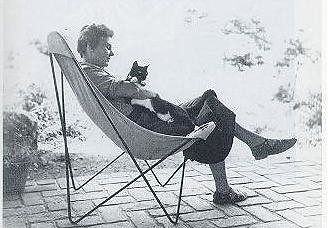Within the history of the
Bishop herself seems to have had no particular interest in these sort of questions. But her discipleship of Marianne Moore went well beyond the aesthetic. Moore, personal friends with Williams Carlos Williams, H.D. & Ezra Pound, working as the editor of The Dial, positioned herself perfectly midway between modernism and the pre-agrarian SoQ poets of her day.
Reading Bishop, we find Moore’s fingerprints everywhere (& largely we approve): in Bishop’s line, in her vocabulary with its modernist preference for the particular, in her sense that the sound elements of traditional verse work best in the New World as an echo, rather than mimicked directly. Nowhere is this more directly acknowledged than in “Invitation to Miss Marianne Moore,” of which these are the first two of its eight stanzas:
From
please come flying.
In a cloud of fiery pale chemicals,
please come flying,
to the rapid rolling of thousands of small blue drums
descending out of the mackerel sky
over the glittering grandstand of harbor-water,
please come flying.
Whistles, pennants and smoke are blowing. The ships
are signaling cordially with multitudes of flags
rising and falling like birds all over the harbor.
Enter: two rivers, gracefully bearing
countless little pellucid jellies
in cut-glass epergnes dragging with silver chains.
The flight is safe; the weather is all arranged.
The waves are running in verses this fine morning.
Please come flying.
When was the last time you got to use epergnes in a poem? There are some turns of phrase here – fiery pale chemicals, mackerel sky, countless little pellucid jellies – that are as fine as anything you will find in the work of Allen Ginsberg or Pound or Eliot or Hart Crane. Bishop’s writing at its best is faultless. And her notorious care with the construction of her poems – they often took years to finish – pays off with a verse that can, as here, feel as free anything the Beats ever did. Yet literally the very next poem in the Collected is a work that shows the old forms made new without, in the same instant, ever having been rejected. This is called “The Shampoo”:
The still explosions on the rocks,
the lichens, grow
by spreading, gray, concentric shocks.
They have arranged
to meet the rings around the moon, although
within our memories they have not changed.
And since the heavens will attend
as long on us,
you’ve been, dear friend,
precipitate and pragmatical;
and look what happens. For Time is
nothing if not amenable.
The shooting stars in your black hair
in bright formation
are flocking where,
so straight, so soon?
— Come, let me wash it in this big tin basin,
battered and shiny like the moon.
Eliotic as this poem is, it’s a trifle – as filled with air as any poem about cats – and more than a few phrases here, including the whole last line, could legitimately be called clunkers. Yet the variable line length – legacy of Moore & Eliot both – and that extraordinary A/B/A/C/B/C rhyme scheme are flawless. Unlike the previous “Invitation,” “The Shampoo” is not particularly about the language Bishop deploys – even if, as with pragmatical, she can’t help herself with a Mooresque twist – as it is with its form as form.
It’s hard to imagine Bishop having been born in the same town as Charles Olson, just two years his junior. They seem like creatures almost out of different centuries, yet both are direct & contemporaneous descendants of Pound’s early dicta on how to write. If the agrarians, Warren & Ransom & to some degree Jarrell, had not focused on Lowell as the anointed poet of the next generation right at the moment that their takeover of the academy in their Batman-like costumes as New Critics, and had not Lowell himself looked to Bishop as friend & mentor, one wonders what would have happened to the SoQ, whether, for example, such projects as Plath’s Ariel or Berryman’s Dream Songs could ever have occurred. Just as it is fascinating to contemplate what might have occurred had not Adrienne Rich, herself a part of the Brahmin literary heritage, turned in good part back to Bishop when she rebelled against patriarchal, and well as formal, closure in the 1960s. Just as one wonders, a little wistfully perhaps, what might have happened had Bishop herself known Stein, or become friends with Robert Duncan (they could have had the best discussions of H.D. imaginable). And ultimately it’s Bishop as much as Auden that is the Ashbery influence that has rendered him palatable to the SoQ, even during the years (especially the 1970s) when his program as poet was to openly ridicule the tradition.
I have sometimes pointed to Joanne Kyger as being the key to the jigsaw puzzle that is the New American poetry – she is the one writer who fits, to some degree or other, within every one of its different aesthetics, the lone gal among the poets of the Spicer Circle, the key to the move to the mesa in Bolinas that would join the New York School to the New Western aesthetic of a Phil Whalen, a beat poet formally trained by Hugh Kenner himself. In somewhat parallel – or is it perpendicular? – fashion, Bishop is the key figure that joins so many different elements of the SoQ back to modernism & forward to such aesthetics as 1970s feminism (or at least that side of it that did not rise out of the post-Beat aesthetics of Judy Grahn, Pat Parker & Susan Griffin). It’s a damn shame that Bishop never spent any time on the mesa, hanging out with Creeley, Berkson & Tom Clark. One can only imagine what American poetry might have become.






